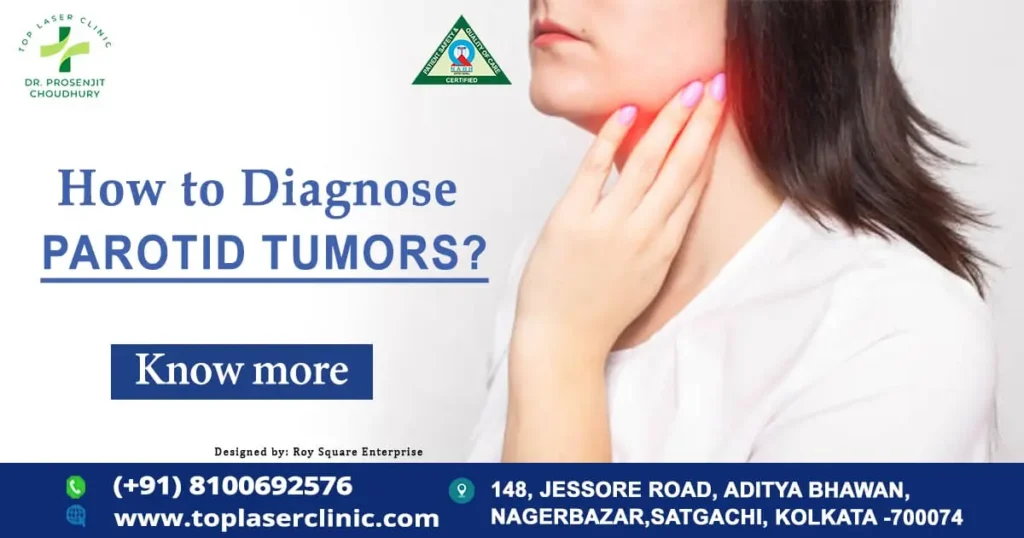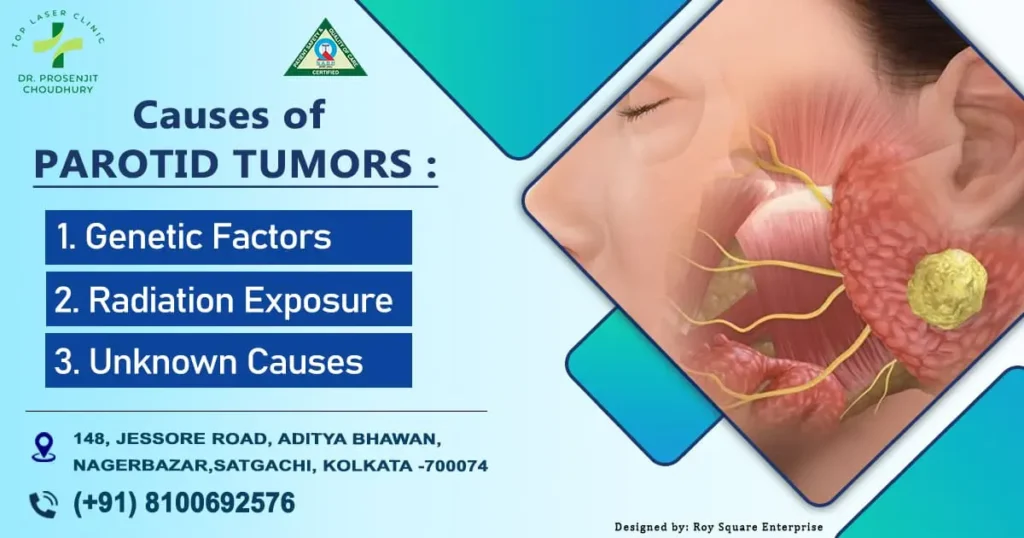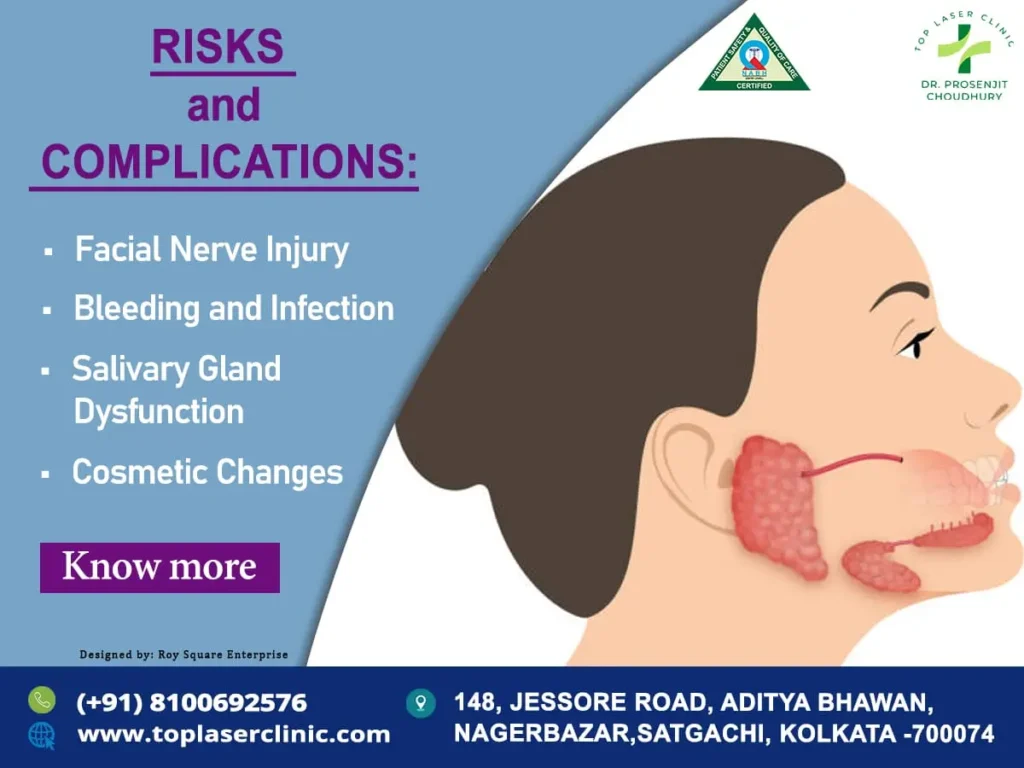Parotid Tumors

Parotid tumors are growths that develop in the parotid glands, which are the largest salivary glands located on either side of the face, just in front of the ears. While most parotid tumors are benign, some can be malignant, posing a serious health concern. In this blog post, we will explore the causes, symptoms, diagnosis, and treatment options for parotid tumors to provide a comprehensive understanding of this medical condition.
Causes of Parotid Tumors:
• Genetic Factors:
-Some parotid tumors may have a genetic component, with a higher risk among individuals with a family history of salivary gland tumors.
• Radiation Exposure:
-Previous exposure to ionizing radiation, especially during childhood, may increase the risk of developing parotid tumors.
• Unknown Causes:
-In many cases, the exact cause of parotid tumors remains unknown, making it challenging to pinpoint specific risk factors.

Symptoms of Parotid Tumors:
• Swelling and Lump Formation: The most common symptom is the development of a painless lump or swelling in the area of the parotid gland.
• Facial Pain or Numbness: Some patients may experience facial pain or numbness, especially if the tumor is pressing on nearby nerves.
• Difficulty Swallowing or Opening Mouth: Larger tumors may interfere with normal jaw movement, causing difficulty in swallowing or opening the mouth.
• Facial Weakness: Facial weakness or paralysis may occur if the tumor affects the facial nerve that runs through the parotid gland.
Often, parotid tumors are confused with that of facial tumors. Remember, “face tumor” is a broad term that could refer to any abnormal growth or mass occurring on the face. They can originate from various tissues, such as skin, muscles, bones, or salivary glands.
Here are a few types of face tumors with different origins that can give you a clear idea and help you to differentiate among them:
1.Skin Tumors:
a) Basal Cell Carcinoma (BCC): A common form of skin cancer that typically appears on sun-exposed areas, including the face.
b) Squamous Cell Carcinoma (SCC): Another skin cancer that can occur on the face due to prolonged sun exposure.
2.Salivary Gland Tumors:
a) Parotid Tumors: Tumors that develop in the parotid glands, the largest salivary glands located on either side of the face.
3.Soft Tissue Tumors:
a) Fibrous Tumors: Soft tissue tumors that can occur on the face, often benign but can vary in nature.
4.Bone Tumors:
a) Osteoma: A benign bone tumor that can develop on facial bones.
5.Neurofibromas:
a)Neurofibromatosis: A genetic disorder that can cause the development of tumors, including those on the face.
It’s important to note that the term “face tumor” is quite general, and the specific diagnosis and treatment would depend on the type, location, and characteristics of the tumor. If someone is experiencing a growth or mass on their face, it’s essential to seek medical attention promptly for a proper evaluation, diagnosis, and appropriate management. Early detection and treatment can significantly impact outcomes, especially if the tumor is cancerous.
Classification
Understanding the classification of parotid tumors is crucial for accurate diagnosis, effective treatment, and improved patient outcomes. Following are the diverse types of parotid tumors based on histology, behavior, and cellular origin.
1.Histological Classification:
A. Benign Parotid Tumors:
i. Pleomorphic Adenoma:
Overview: The most common benign parotid tumor.
Histology: Features a mix of epithelial and myoepithelial cells.
ii. Warthin Tumor:
Overview: The second most common benign tumor.
Histology: Characterized by cystic spaces and oncocytic cells.
iii. Monomorphic Adenoma:
Overview: Less common than pleomorphic adenoma.
Histology: Composed of a single type of cell – either epithelial or myoepithelial.
iv. Basal Cell Adenoma:
Overview: A rare benign tumor.
Histology: Composed of basaloid cells.
B. Malignant Parotid Tumors:
i. Mucoepidermoid Carcinoma:
Overview: The most common malignant tumor.
Histology: A mix of mucin-producing, squamous, and intermediate cells.
ii. Adenoid Cystic Carcinoma:
Overview: Slow-growing but often aggressive.
Histology: Characterized by cribriform and tubular growth patterns.
iii. Acinic Cell Carcinoma:
Overview: Composed of cells similar to serous acinar cells.
Histology: Generally has a favorable prognosis.
iv. Squamous Cell Carcinoma:
Overview: Arises from the surface epithelium.
Histology: Less common in the parotid gland compared to mucoepidermoid carcinoma.
2.Behavior Classification:
- Benign Parotid Tumors:
Characteristics: Non-cancerous, do not invade surrounding tissues.
Examples: Pleomorphic adenoma, Warthin tumor. - Malignant Parotid Tumors:
Characteristics: Have the potential to invade nearby tissues and spread.
Examples: Mucoepidermoid carcinoma, Adenoid cystic carcinoma.
3.Cellular Origin Classification:
- Epithelial Parotid Tumors:
Origination: From the glandular tissue.
Examples: Pleomorphic adenoma, Mucoepidermoid carcinoma. - Myoepithelial Parotid Tumors:
Origination: From myoepithelial cells.
Examples: Pleomorphic adenoma.
4.Mixed Cell Type Classification:
A.Mixed Parotid Tumors:
Composition: Combination of cell types (epithelial and myoepithelial).
Examples: Pleomorphic adenoma, Mucoepidermoid carcinoma.
The classification of parotid tumors provides a roadmap for healthcare professionals to navigate the complexities of diagnosis and treatment. Each subtype presents unique challenges and considerations, underscoring the importance of a tailored approach to patient care. As medical research advances, our understanding of parotid tumors continues to evolve, offering hope for improved diagnostic precision and therapeutic strategies in the future. For individuals facing concerns related to parotid tumors, seeking prompt medical attention and consulting with specialists are key steps toward effective management and a positive prognosis.
Know about abluminal cells
Within the intricate world of vascular biology, there exists a group of cells that often take a backstage role but play a crucial part in maintaining the delicate balance of microvascular dynamics. These cells, known as abluminal cells, contribute to the structural integrity and functionality of blood vessels, ensuring that the intricate web of vessels throughout our bodies functions seamlessly. Abluminal cells refer to the cells situated on the outer side of blood vessels, away from the vessel lumen. They form a crucial part of the vessel wall. Abluminal cells are found in capillaries, venules, and arterioles, playing distinct roles in each segment of the microvascular network.
In the intricate ballet of microvascular regulation, abluminal cells emerge as silent conductors, orchestrating a symphony of functions essential for health and homeostasis. As ongoing research continues to unveil the nuances of their roles, the significance of these cells in both physiological and pathological states becomes increasingly apparent. Appreciating the contributions of abluminal cells is not only a testament to the complexity of vascular biology but also paves the way for innovative therapeutic strategies aimed at preserving microvascular health.
How to Diagnose Parotid Tumors:
- Physical Examination: A thorough physical examination, including palpation of the parotid gland, is the first step in diagnosing parotid tumors.
- Imaging Studies: Imaging tests such as ultrasound, CT scans, and MRI scans help visualize the size, location, and characteristics of the tumor.
- Biopsy: A biopsy may be performed to determine whether the tumor is benign or malignant. Fine-needle aspiration (FNA) is a common biopsy technique.
Treatment Options:
- Surgery: Surgical removal of the tumor is a common treatment, and the extent of surgery depends on whether the tumor is benign or malignant.
- Radiation Therapy: Radiation therapy may be recommended, particularly for malignant tumors or cases where complete surgical removal is challenging.
- Chemotherapy: In some cases of malignant parotid tumors, chemotherapy may be utilized to target cancer cells and prevent their growth.
- Follow-up Care: Regular follow-up appointments are crucial to monitor for any recurrence or new developments.
- Radical parotidectomy: Radical parotidectomy is a surgical procedure that involves the complete removal of the parotid gland. The parotid gland is the largest of the salivary glands and is located on either side of the face, just in front of the ears. This procedure is typically performed to treat certain types of parotid tumors, especially those that are malignant or invasive.
When Radical Parotidectomy is Recommneded?
- Malignant Tumors: Radical parotidectomy is commonly recommended for the treatment of malignant parotid tumors, such as mucoepidermoid carcinoma, adenoid cystic carcinoma, and others.
- Extensive Tumors: When the tumor is large or extends deeply into surrounding tissues, a radical approach may be necessary to ensure complete removal.
- Recurrent Tumors: In cases where the tumor has returned after previous treatment, a radical parotidectomy may be considered to address the recurrence.
Procedure of Radical Parotidectomy:
- Incision: The surgery begins with an incision made in front of or just below the ear, extending down toward the neck. The precise location of the incision depends on the size and location of the tumor.
- Identification and Preservation of Facial Nerve: The facial nerve, responsible for controlling facial muscles, runs through the parotid gland. Special care is taken to identify and preserve the facial nerve during surgery to minimize the risk of facial weakness or paralysis.
- Gland Removal: The parotid gland is carefully dissected and removed from the surrounding tissues. The extent of removal depends on the size and nature of the tumor.
- Lymph Node Dissection (if needed): In some cases, especially if there is concern about lymph node involvement, the surgeon may perform a selective neck dissection to remove nearby lymph nodes.
- Closure: Once the parotid gland and any necessary lymph nodes are removed, the incision is closed with sutures. The surgeon may use techniques to minimize scarring and optimize cosmetic outcomes.
Recovery and Postoperative Care:
- Pain Management: Patients may experience pain and discomfort after surgery, which can be managed with pain medications prescribed by the healthcare team.
- Facial Rehabilitation: Physical therapy and facial exercises may be recommended to help regain strength and function in the facial muscles, especially if there was any manipulation of the facial nerve during surgery.
- Follow-up Care: Regular follow-up appointments are essential to monitor healing, address any complications, and check for signs of recurrence.
Risks and Complications:

- Facial Nerve Injury: Despite efforts to preserve the facial nerve, there is a risk of injury, which could lead to temporary or permanent facial weakness.
- Bleeding and Infection: As with any surgery, there is a risk of bleeding and infection, which is closely monitored and treated as needed.
- Salivary Gland Dysfunction: Removal of the parotid gland can result in decreased saliva production on the affected side.
- Cosmetic Changes: Changes in facial appearance, such as contour irregularities, may occur after surgery.
Radical parotidectomy is a complex procedure that requires careful consideration of the tumor characteristics and the patient’s overall health. The decision to undergo this surgery is typically made collaboratively between the patient, the surgeon, and other members of the healthcare team. It is crucial for individuals undergoing radical parotidectomy to have a thorough understanding of the potential risks, benefits, and postoperative care to make informed decisions about their treatment.
Understanding the causes, symptoms, and treatment options for parotid tumors is essential for both patients and healthcare professionals. Early detection and intervention play a critical role in achieving successful outcomes, and ongoing research aims to improve our knowledge and treatment modalities for this condition. If you suspect any symptoms related to parotid tumors, it is imperative to consult with a healthcare professional promptly.